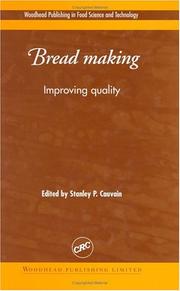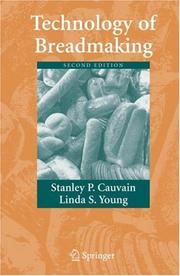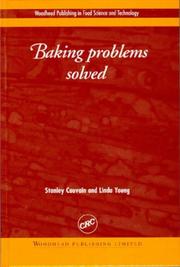| Listing 1 - 10 of 22 | << page >> |
Sort by
|
Book
ISBN: 9783319146874 3319146866 9783319146867 3319146874 Year: 2015 Publisher: Cham : Springer International Publishing : Imprint: Springer,
Abstract | Keywords | Export | Availability | Bookmark
 Loading...
Loading...Choose an application
- Reference Manager
- EndNote
- RefWorks (Direct export to RefWorks)
This practical, comprehensive guide illuminates all aspects of breadmaking to give bakers, scientists, technologists and students a thorough understanding of the many new developments shaping the industry. The book bridges the gap between scientific and practical accounts by providing technical coverage of the complex processes that link together to make bread and fermented products. Chapters cover the nature of bread products, the role of the ingredients in determining their quality, processing methods and their control, and equipment functions. Emphasis is on exploring the contributions of individual components and processing stages to final bread quality, reviewing the current state of technical knowledge on breadmaking. This third edition reviews the new knowledge which has become available in the last 10 years and considers how the global trends of increased availability and wider range of fermented products around the world impact on current and future technological challenges for bakers. Stanley P. Cauvain is the Director and Vice President of Research and Development activities at BakeTran, and Professor at the International Institute of Agri-Food Security, Curtin University, Perth, Western Australia.
Chemistry. --- Food Science. --- Food science. --- Chimie --- Health & Biological Sciences --- Biomedical Engineering --- Bread. --- Baking. --- Bread industry. --- Breads --- Food --- Biotechnology. --- Baked products industry --- Cooking --- Baked products --- Cooking (Bread) --- Science --- Food—Biotechnology.
Digital
ISBN: 9783319146874 9783319146881 9783319146867 9783319330648 Year: 2015 Publisher: Cham Springer International Publishing
Abstract | Keywords | Export | Availability | Bookmark
 Loading...
Loading...Choose an application
- Reference Manager
- EndNote
- RefWorks (Direct export to RefWorks)
This practical, comprehensive guide illuminates all aspects of breadmaking to give bakers, scientists, technologists and students a thorough understanding of the many new developments shaping the industry. The book bridges the gap between scientific and practical accounts by providing technical coverage of the complex processes that link together to make bread and fermented products. Chapters cover the nature of bread products, the role of the ingredients in determining their quality, processing methods and their control, and equipment functions. Emphasis is on exploring the contributions of individual components and processing stages to final bread quality, reviewing the current state of technical knowledge on breadmaking. This third edition reviews the new knowledge which has become available in the last 10 years and considers how the global trends of increased availability and wider range of fermented products around the world impact on current and future technological challenges for bakers. Stanley P. Cauvain is the Director and Vice President of Research and Development activities at BakeTran, and Professor at the International Institute of Agri-Food Security, Curtin University, Perth, Western Australia.
Nutritionary hygiene. Diet --- Food science and technology --- voedingstechnologie --- voedingsleer

ISBN: 0857095692 0857090607 1280372885 9786610372881 1591246369 1855737124 9781855737129 0203495004 9780203495001 1855735539 9781855735538 9781855735538 9780849317620 0849317622 9780857095695 9780857090607 9780857090607 Year: 2003 Publisher: Boca Raton Cambridge, Eng. CRC Press Woodhead
Abstract | Keywords | Export | Availability | Bookmark
 Loading...
Loading...Choose an application
- Reference Manager
- EndNote
- RefWorks (Direct export to RefWorks)
There has been a wealth of recent research on the complex changes involved in bread making and how they influence the many traits consumers use to define quality. Bread making: improving quality sums up this key research and what it means for improved process control and a better, more consistent product. After an introductory review of bread making as a whole part one discusses wheat and flour quality. Chapter 3 summarises current research on the structure of wheat, providing the context for chapters on wheat proteins (chapters 5 and 6) and starch (chapter 7). There are also chapters on ways of measuring wheat and flour quality, and improving flour for bread making. Part two reviews dough formation and its impact on the structure and properties of bread. It includes chapters on the molecular structure of dough, foam formation and bread aeration together with discussion of the role of key ingredients such as water. A final group of chapters then discusses other aspects of quality such as improving taste and nutritional properties, as well as preventing moulds and mycotoxin contamination. With its distinguished editor and international team of contributors, Bread making: improving quality is a standard work both for industry and the research community.
Baking. --- Bread industry. --- Bread. --- Bread --- Baking --- Social Sciences --- Recreation & Sports --- Baked products industry --- Cooking --- Breads --- Baked products --- Cooking (Bread) --- Brood : bereiding --- 664.6 --- Microbiology. --- Production control. --- Quality control. --- Bacteriology
Book
ISBN: 0081025203 008102519X 9780081025192 9780081025208 Year: 2021 Publisher: Oxford
Abstract | Keywords | Export | Availability | Bookmark
 Loading...
Loading...Choose an application
- Reference Manager
- EndNote
- RefWorks (Direct export to RefWorks)
Bread. --- Bread industry. --- Baked products industry --- Breads --- Baked products --- Cooking (Bread)
Book
ISBN: 9780857095695 0857095692 0857090607 9780857090607 Year: 2012 Publisher: Philadelphia, Pa Woodhead Pub.
Abstract | Keywords | Export | Availability | Bookmark
 Loading...
Loading...Choose an application
- Reference Manager
- EndNote
- RefWorks (Direct export to RefWorks)
The first edition of Breadmaking: Improving quality quickly established itself as an essential purchase for baking professionals and researchers in this area. With comprehensively updated and revised coverage, including six new chapters, the second edition helps readers to understand the latest developments in bread making science and practice. The book opens with two introductory chapters providing an overview of the breadmaking process. Part one focuses on the impacts of wheat and flour quality on bread, covering topics such as wheat chemistry, wheat starch structure, grain quality assessment, milling and wheat breeding. Part two covers dough development and bread ingredients, with chapters on dough aeration and rheology, the use of redox agents and enzymes in breadmaking and water control, among other topics. In part three, the focus shifts to bread sensory quality, shelf life and safety. Topics covered include bread aroma, staling and contamination. Finally, part four looks at particular bread products such as high fibre breads, those made from partially baked and frozen dough and those made from non-wheat flours. With its distinguished editor and international team of contributors, the second edition of Breadmaking: Improving quality is a standard reference for researchers and professionals in the bread industry and all those involved in academic research on breadmaking science and practice. With comprehensively updated and revised coverage, this second edition outlines the latest developments in breadmaking science and practice Covers topics such as wheat chemistry, wheat starch structure, grain quality assessment, milling and wheat breeding Discusses dough development and bread ingredients, with chapters on dough aeration and rheology.
Bread. --- Baking. --- Bread industry. --- Baked products industry --- Cooking --- Breads --- Baked products --- Cooking (Bread)
Digital
ISBN: 9780857095695 0857095692 0857090607 9780857090607 Year: 2012 Publisher: Philadelphia, Pa Woodhead Pub
Abstract | Keywords | Export | Availability | Bookmark
 Loading...
Loading...Choose an application
- Reference Manager
- EndNote
- RefWorks (Direct export to RefWorks)
The first edition of Breadmaking: Improving quality quickly established itself as an essential purchase for baking professionals and researchers in this area. With comprehensively updated and revised coverage, including six new chapters, the second edition helps readers to understand the latest developments in bread making science and practice. The book opens with two introductory chapters providing an overview of the breadmaking process. Part one focuses on the impacts of wheat and flour quality on bread, covering topics such as wheat chemistry, wheat starch structure, grain quality assessment, milling and wheat breeding. Part two covers dough development and bread ingredients, with chapters on dough aeration and rheology, the use of redox agents and enzymes in breadmaking and water control, among other topics. In part three, the focus shifts to bread sensory quality, shelf life and safety. Topics covered include bread aroma, staling and contamination. Finally, part four looks at particular bread products such as high fibre breads, those made from partially baked and frozen dough and those made from non-wheat flours. With its distinguished editor and international team of contributors, the second edition of Breadmaking: Improving quality is a standard reference for researchers and professionals in the bread industry and all those involved in academic research on breadmaking science and practice. With comprehensively updated and revised coverage, this second edition outlines the latest developments in breadmaking science and practiceCovers topics such as wheat chemistry, wheat starch structure, grain quality assessment, milling and wheat breedingDiscusses dough development and bread ingredients, with chapters on dough aeration and rheology.
Digital
ISBN: 1855737124 9781855737129 0203495004 9780203495001 1855735539 9781855735538 Year: 2003 Publisher: Cambridge, Eng Woodhead
Abstract | Keywords | Export | Availability | Bookmark
 Loading...
Loading...Choose an application
- Reference Manager
- EndNote
- RefWorks (Direct export to RefWorks)
There has been a wealth of recent research on the complex changes involved in bread making and how they influence the many traits consumers use to define quality. Bread making: improving quality sums up this key research and what it means for improved process control and a better, more consistent product. After an introductory review of bread making as a whole part one discusses wheat and flour quality. Chapter 3 summarises current research on the structure of wheat, providing the context for chapters on wheat proteins (chapters 5 and 6) and starch (chapter 7). There are also chapters on ways of measuring wheat and flour quality, and improving flour for bread making. Part two reviews dough formation and its impact on the structure and properties of bread. It includes chapters on the molecular structure of dough, foam formation and bread aeration together with discussion of the role of key ingredients such as water. A final group of chapters then discusses other aspects of quality such as improving taste and nutritional properties, as well as preventing moulds and mycotoxin contamination. With its distinguished editor and international team of contributors, Bread making: improving quality is a standard work both for industry and the research community.
Book
ISBN: 9780857090607 Year: 2012 Publisher: Oxford : Woodhead Publishing Limited,
Abstract | Keywords | Export | Availability | Bookmark
 Loading...
Loading...Choose an application
- Reference Manager
- EndNote
- RefWorks (Direct export to RefWorks)
664.661 --- Bread, rolls and buns exclusively or mainly from whole-grain wheat, wholemeal wheat or wheat flour. Wholemeal bread. White bread. Bread rolls. Currant buns etc. --- 664.661 Bread, rolls and buns exclusively or mainly from whole-grain wheat, wholemeal wheat or wheat flour. Wholemeal bread. White bread. Bread rolls. Currant buns etc. --- Baking --- Bread --- Breads --- Baked products --- Cooking (Bread) --- Cooking --- Bread, rolls and buns exclusively or mainly from whole-grain wheat, wholemeal wheat or wheat flour. Wholemeal bread. White bread. Bread rolls. Currant buns etc

ISBN: 1280863838 9786610863839 0387385657 0387385630 1489987304 Year: 2007 Publisher: New York, NY : Springer US : Imprint: Springer,
Abstract | Keywords | Export | Availability | Bookmark
 Loading...
Loading...Choose an application
- Reference Manager
- EndNote
- RefWorks (Direct export to RefWorks)
To study breadmaking is to realize that, like many other food processes, it is constantly changing as processing methodologies become increasingly more sophisticated, yet at the same time we realize that we are dealing with a foodstuff, the forms of which are very traditional. New ideas and raw materials are constantly being presented to bakers from wheat breeders, millers and ingredient and equipment suppliers for their evaluation. In addition there are on-going changes in legislation and consumer demands. To meet such pressures bakers must be able to better integrate their key raw material, wheat flour, with other ingredients and processing methods to deliver bread of the appropriate quality. Technology of Breadmaking, Second Edition, sets out to identify and present the new knowledge that has become available in last 10 years, as well as update information. Like the first edition, it provides a useful tool to help bakers, scientists and technologists to cope with those changes. About the Authors Stanley P. Cauvain is the Director and Vice President of Research and Development activities at BakeTran. Linda S. Young is a Director and Vice President of Knowledge Systemization and Training at BakeTran. .
Bread. --- Baking. --- Bread industry. --- Baked products industry --- Cooking --- Breads --- Baked products --- Cooking (Bread) --- Food science. --- Food Science. --- Science --- Food—Biotechnology.

ISBN: 1855735644 9786610372591 1591243343 1280372591 1855736187 9781855736184 9781855735644 9780081007686 008100768X 9781591243342 0849312213 9780849312212 9780081007655 0081007655 Year: 2001 Publisher: Duxford, [England] ; Cambridge, [Massachusetts] ; Kidlington, [England] : Woodhead Publishing,
Abstract | Keywords | Export | Availability | Bookmark
 Loading...
Loading...Choose an application
- Reference Manager
- EndNote
- RefWorks (Direct export to RefWorks)
When things go wrong in the bakery, the pressures of production do not allow time for research into the solution. Solving these baking problems has always been the province of 'experts'. However, with a methodical approach, keen observation and a suitable reference book then the answers to many bakery problems are straightforward. Baking problems solved is designed to help the busy bakery professional find the information they need quickly. It also enables them to understand the causes and implement solutions. It is arranged in a practical question-and-answer format, with over 200 frequently a
Engineering --- Food Science and Technology --- Baking. --- Baked products industry. --- Baked products. --- Baked goods --- Bakery products --- Morning goods --- Food --- Baking industry --- Food industry and trade --- Cooking
| Listing 1 - 10 of 22 | << page >> |
Sort by
|

 Search
Search Feedback
Feedback About
About Help
Help News
News